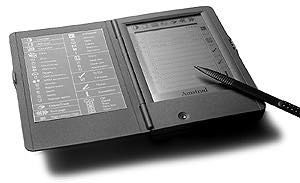
AMSTRAD could quite rightly accuse me of being a little late with this short review, so I see no point in hiding the truth - the PenPad PDA 600 didn't appeal to me when it was launched almost two years ago.
Regular printed edition readers will remember a review of Psion's keyboard-based rival in the Dec/Jan 94 issue, and at the time the PDA was fairly expensive at over £200 ($320 approx), despite having a mere 128K RAM.
It was recently brought to my attention, however, that the price has come down, to £117.50 inc VAT (to business users in Britain that means £99, or $160), and the lack of a keyboard made me think that it was due for some coverage.
First of all - price is a real factor here. The Psion product (which I still use) is still £299, and features a very small keyboard which may put some users off. £99 is almost disposable money these days, and if the Amstrad has something to offer then it could have been a bargain.
Using the system is fairly straightforward - it learns most handwritten letter-forms quickly, and there is a crib sheet which explains all the icons and functions. The pen is light and easy to use, and the LCD screen clear in most situations.
I decided to use the PenPad in place of my Psion for a week, and see if it could meet some of my requirements (it doesn't have a word processor as standard, so this rather vital function was ignored).
Problems were soon apparent - while some letters were quickly recognised, others remained elusive, and no other input method exists. Perseverance provided me with only 90% reliability.
Its strongest point is the To Do list which appears - only if it contains an entry - when the PDA is switched on. This aspect of organization is not as easy to use on my Psion. The action of ticking boxes is ideally suited to a pen-based interface.
NotePad is also impressive software, providing almost perfect representations of whatever you draw. But that is all it does - no exporting the file, no printing out, no faxing. This is a real failing, especially for Arabic, Japanese and other non-Roman script users.
The software is not capable of processing such graphic input. Amstrad are releasing a much improved version, the PCI 700, and this promises much more functionality, but at a price.
The PDA 600, in conclusion, is very much an organizer, not a portable computer, and is fairly-priced as such. If you don't need the extra functionality of a Psion and like the idea of pen-based input and control, try the Amstrad. They need a new killer product, a 1995 equivalent of the PCW which trailblazed the home PC market in early 1980s Britain (and gave publishers a disk translation headache which STILL hasn't disappeared! - Editor). I hope the PCI 700 is it.
Return to July contents